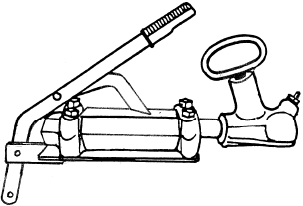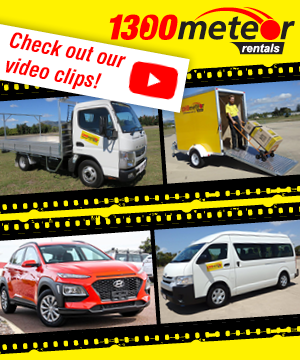Towing Tips for Trailers
We wish you a safe and incident free journey when towing one of our trailers (whether behind your vehicle or ours!) We trust you will find the following tips very helpful in this regard.
Before moving off
Even though our staff may hook the trailer up for you, it is the driver's responsibility to check that all is in order before moving off, including:
- the trailer coupling is securely attached to the towbar, and latched.
- the trailer safety chains are also securely attached to the tow bar, and that the shackle pins are nipped up tight - these chains should be attached with a minimum of slack (but enough to allow the trailer to turn). Where a pair of chains is fitted, cross them under the drawbar before attaching them to the towbar.
- the trailer lights are all operational - our staff will assist you in this regard.
- the handbrake is off - all of our trailers fitted with brakes are also fitted with a a handbrake, which forms part of the tow coupling.
- ensuring that on trailers fitted with override brakes that the collar positioned directly behind the coupling release handle is flipped outwards, otherwise the brakes will not function! When reversing the trailer this collar should be flipped back over the coupling shaft otherwise the brakes will be applied. When on the move (forwards) again flip the collar out again.
 What are override brakes? The tow coupling to an override breaking system sliding shaft which is moved by inertia when the tow vehicle applies its brakes - the sliding shaft in turn applies the trailer brakes via a wire cable.
What are override brakes? The tow coupling to an override breaking system sliding shaft which is moved by inertia when the tow vehicle applies its brakes - the sliding shaft in turn applies the trailer brakes via a wire cable.
- the trailer has a spare wheel fitted.
- you have tyre changing tools with you - the tow vehicles' jack should be sufficient for the trailer, and if the wheel brace won't fit the wheel nuts to our trailer we will gladly loan you one free of charge.
Loading the trailer
Load the trailer so that there is positive weight on the drawbar/towbar (around 50-75kg). NEVER load the trailer in such a way that there is negative weight on the towbar as it is dangerous and will lead to the instability of the tow vehicle.
Do not overload your vehicles, or the trailer.
Ensure the load is properly secured.
On the move
Towing a trailer isn't that difficult, but it does required a LOT MORE CARE.
Because your vehicle and trailer combination is now bigger, heavier and longer than before it is wise to travel more slowly than you would normally - lower speeds will put less stress on you and the vehicle and will also save on fuel.
Keep to the left lane so that faster traffic is not impeded. Keep a safe distance behind the vehicle in front - remember that with a trailer behind your vehicle you will require a far greater distance to slow down or pull up.
Normal touring speeds of 80-90km/hour may be maintained, but high speeds should be avoided, not only for safety reasons but also for fuel economy.
Be careful when overtaking - remember that the overall length of your vehicle is substantially longer with a trailer on behind, and your acceleration will be reduced, especially if towing a large tandem axled trailer.
If the overall width of the trailer is wider that the tow vehicle take special care when turning corners or pulling alongside kerbs, shop verandah posts, fuel bowsers and the like, as the may be missed by the tow vehicle but not the trailer.
With high trailers such as our fully enclosed furniture vans, keep in mind its height when passing under trees or other overhangs.
Don't wander, weave or swerve or you will set up a sway motion at speed.
If the trailer does start swaying and threatens to take control away from the towing vehicle do not apply the brakes. Gently apply power until control is re-established.
Avoid sudden manoeuvres as they may well lead to the loss of control.
Loose gravel on bends of the road should not be approached too fast. If a "slide" be encountered, drive out gradually, easing speed, but do not apply the brakes.
Rough or corrugated roads should be taken at low speed.
During the trip
After travelling a few kilometres pull up in a safe location. Walk methodically around the trailer to ensure all is in order, including:
- coupling and safety chains still fastened
- lights are still working
- tyres are still inflated correctly
- loads, doors etc are still properly secured
On long trips, repeat these checks every 2-3 hours when taking a rest stop.
 Hill climbs & descents
Hill climbs & descents
Your vehicles' engine will work hardest when climbing hills, and therefore great care should be taken to ensure it doesn't overheat. Keep a close eye on the temperature gauge at all times and investigate any sudden rises in temperature.
When descending, make use of the engine as a brake, by selecting a lower gear (before starting your downhill run) - as a guide, select the same gear going down as you did coming up. (In the case of automatic transmissions it is permissible to manually select a lower gear in order to maximise engine breaking.)
WARNING: Never descend on any downhill run (short or long) with the gearbox in neutral - with no engine breaking whatsoever the vehicle will quickly run away and greatly increase the risk of the driver losing control.
Reversing the trailer
Check the immediate area around and behind the trailer using the tow vehicle's mirrors. If unsure what is behind the trailer the driver should get out and inspect first hand. Alternatively, have someone guide the driver whilst standing in the driver's field of vision (and never behind the tow vehicle or trailer).
As you will not always reverse with the tow vehicle in line with the trailer, primary consideration should be given to the position of the front trailer.
With one hand placed on the bottom of the steering wheel, move it to the right to move the trailer to right, or to the left to reverse towards the left; in other words, steer the tow vehicle in the opposite direction to that normally taken.
Keep these tips in mind and have a safe journey!
Disclaimer: The information contained on this site is general and is not intended to be advice on any matter. Nothing contained herein is intended to constitute an offer, inducement, promise or contract of any kind. Please refer to the terms and conditions of this website for further information.
admin


)
)
)
)
)
)
)
)
)

 What are override brakes? The tow coupling to an override breaking system sliding shaft which is moved by inertia when the tow vehicle applies its brakes - the sliding shaft in turn applies the trailer brakes via a wire cable.
What are override brakes? The tow coupling to an override breaking system sliding shaft which is moved by inertia when the tow vehicle applies its brakes - the sliding shaft in turn applies the trailer brakes via a wire cable. Hill climbs & descents
Hill climbs & descents


